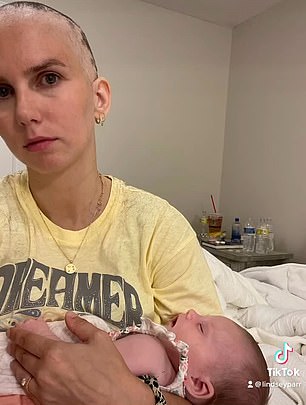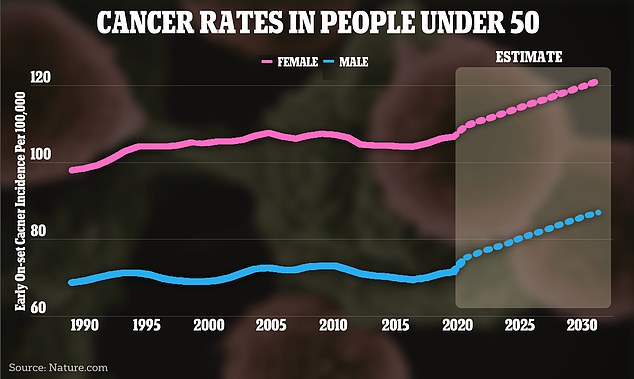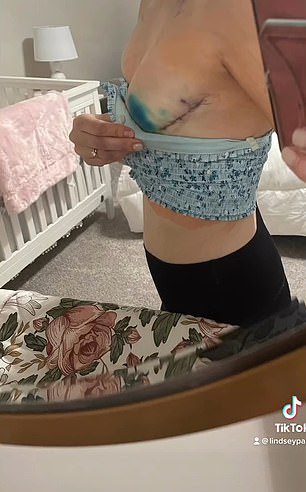A Georgia mother has had her astonishing cancer roller coaster ride revealed, in which she was diagnosed with terminal cancer days before giving birth and was declared “miraculously” cancer-free six months later.
Despite initially being given six months to live, Lindsey Parr Gritton, 31, was given the all-clear after just three months of chemotherapy and immunotherapy infusions.
Now, two years later, scans still show no signs of disease.
“My doctor is still completely shocked that I’m still in remission,” he said. “It’s just a miracle.”

Lindsey Parr Gritton was 29 years old and 36 weeks pregnant when she found a lump in her breast. After giving birth to her daughter prematurely, she was diagnosed with stage four breast cancer.
Mrs. Gritton was just 29 years old and 36 weeks pregnant with her second child when she went to her OB-GYN for a routine checkup.
For several months, Mrs Gritton had suffered from burning pain in her chest, along with a small lump and swollen lymph nodes near her armpit.
However, doctors thought it was simply mastitis, an inflammation of the breast tissue that could be caused by a blocked milk duct or bacteria.
Mrs Gritton insisted on an ultrasound of the lump, which turned out to be “highly suspicious for cancer”. Further tests revealed stage four breast cancer, which had spread to the liver.

The graph above shows the change in cancer case rates around the world.
Within a week, Mrs Gritton, now 31, was induced to hasten the birth of her baby and, days after the birth, began chemotherapy.
“The results were terrifying and heartbreaking,” Ms. Gritton said in a recent talk. “I was suddenly labeled a stage four cancer patient and given a prognosis of six short months to live.”
‘How was I supposed to raise a newborn and a toddler and go through six months of chemotherapy at the same time? And how was she supposed to explain to my two-year-old son that Mom had to go to heaven soon?
Ms. Gritton is just one of many young Americans diagnosed with cancer, whose rates in those under 50 have soared 30 percent in just 20 years.
Breast cancer is the most common form of cancer in both the US and the world.
The National Cancer Institute (NCI) estimates there will be more than 300,000 new cases this year, along with 43,700 deaths.
Death rates have plummeted 43 percent between 1989 and 2020, after successful public health awareness campaigns, better screening and new medications.
And nine out of 10 patients are expected to survive after five years. However, once the cancer metastasizes or spreads, the survival rate drops to 31 percent, according to the American Cancer Society (ACS).


Mrs. Gritten underwent six months of chemotherapy and immunotherapy, which shrank her tumors. She also underwent a lumpectomy to remove any remaining cancer.
Mrs Gritton received infusions of a combination of three different chemotherapy and immunotherapy drugs every three weeks.
During this time, she “enjoyed every moment even more because I thought I had limited time,” she told People.
”I was taking in every second, trying to absorb it all. I made a scrapbook, wrote letters to my kids, made videos, everything. ‘She was trying to do everything she could.’
About three months after starting treatment, scans showed Mrs Gritton’s tumors were shrinking. After six months, “everything was gone” and he had no evidence of illness.
“We were very happy when we found out there was no cancer in my body,” she said. “Honestly, we couldn’t, no one could believe it. He was really crazy and surreal.”
Ms Gritton then underwent a lumpectomy, which aims to remove the cancer and surrounding tissue. Unlike a mastectomy, patients do not lose the entire breast.


Mrs Gritton has no cancer cells left and undergoes immunotherapy every six months to prevent the disease from recurring. The mother of two also just celebrated her 31st birthday this month, something she never thought she would see.

“I don’t even take five minutes for granted,” Ms. Gritton said in a recent talk.
Mrs Gritton has no cancer cells left and undergoes immunotherapy every six months to prevent the disease from recurring. The mother of two also just celebrated her 31st birthday this month, something she never thought she would see.
“It’s really surreal because I just didn’t think I’d be here,” he said. “Every moment is just incredible.”
Mrs Gritton is also working to raise awareness about breast cancer, especially as cancer rates rise among young people.
Although the average age of diagnosis in the U.S. is 62, recent research shows that rates among women ages 20 to 49 have slowly increased.
Experts are still working to unravel the cause, although the increase has largely been attributed to Western diets and sedentary lifestyles.
Furthermore, researchers from Washington University in St. Louis have discovered that generations with higher rates of cancer have cells and tissues in their bodies that have aged faster.
In other words, people born after 1965 (age 59 or younger) may be biologically older than their chronological age.
“Everyone thinks breast cancer occurs after age 40. You don’t really think about it happening when you’re 20,” Ms. Gritton said.
In his recent talk he said: “I don’t even take five minutes for granted.”

